Digital media trends survey has been saved

Digital media trends survey A new world of choice for digital consumers
20 March 2018
 Kevin Westcott United States
Kevin Westcott United States Jeff Loucks United States
Jeff Loucks United States Kevin Downs United States
Kevin Downs United States Jeanette Watson United States
Jeanette Watson United States
Digital media consumers across generations are increasingly in the driver’s seat—and their expectations are at an all-time high. Some major shifts are now occurring. What are the implications for technology, media, and telecommunications companies?
Introduction
Learn More
View the 2019 Digital Media Trends
How do your habits measure up? Take the interactive survey to find out.
Watch the video and view the infographic
Listen to the related podcast on Deloitte.com
Explore the Thinking Fast charticle series on Deloitte.com
Learn more about the Center for Technology, Media and Telecommunications
Subscribe to receive related content
With the proliferation of mobile devices, wireless connectivity, and alternative digital media platforms, one thing has become clear: Consumers are increasingly in control. They now enjoy unparalleled freedom when it comes to selecting media and entertainment options and their expectations are at an all-time high.
Consumers today want original, high-quality content, and are less willing to pay for packages containing programming they’ll never watch. They are demanding the ability to view content whenever, wherever, and in the format that best suits their needs at any given moment. And, more than ever before, they are willing to leave providers who don’t satisfy these requirements.
To understand where things stand today, and where they are going, every year Deloitte’s Technology, Media & Telecommunications practice examines the generational habits of US consumers. We do this to uncover the shifting attitudes and behaviors that involve entertainment devices, advertising, media consumption, social media, and the Internet.
In our Digital media trends survey, 12th edition (formerly the Digital democracy survey), we uncovered several key insights that illustrate major shifts in media consumption:
- Streaming video crosses the chasm. The adoption of streaming video subscriptions continues to grow—fueled by consumers’ strong desire for original content and the flexibility to consume media wherever and whenever they want.
- Pay TV’s “value gap” is expanding. The growth of streaming video has, in part, led consumers to reassess the value of their pay TV subscriptions. There is a widening value gap between what they expect and what pay TV providers actually deliver.
- Emergence of the “MilleXZials.” The survey revealed that younger generations are not the only ones driving these trends. In particular, the mobile consumption behaviors of Generation X (ages 35–51) now closely mirror those of Generation Z (ages 14–20) and millennials (ages 21–34). We are calling this combined group (Gen Z, millennials, and Gen X) the “MilleXZials.”
- Personal data is increasingly a concern—and an opportunity. With a sizable portion of consumption happening online, all consumers are increasingly protective of their personal data. This creates an opportunity for providers to give customers more control over their personal data.
Here, we explore major highlights from our survey and shed light on what each may signify for the future of digital media.
About Deloitte’s Digital media trends survey
This is the 12th edition of Deloitte’s Digital media trends survey, conducted by Deloitte’s Technology, Media & Telecommunications practice.
The survey provides insight into how five generations of US consumers are interacting with media, products and services, mobile technologies, and the Internet. It also captures consumers’ attitudes and behaviors toward advertising and social networks—and what their preferences might be in the future.
This year’s US data was collected in November 2017 and employed an online methodology among 2,088 consumers across the following age groups:
- Generation Z: ages 14–20 (born 1997–2003)
- Millennials: ages 21–34 (born 1983–1996)
- Generation X: ages 35–51 (born 1966–1982)
- Baby boomers: ages 52–70 (born 1947–1965)
- Matures: ages 71+ (born 1946 or earlier)
All data is weighted back to the US census to give a representative view of the average US consumer. For meaningful changes, we look for differences in year-over-year tracking and generational differences of at least 5 percentage points.
Note that the insights shared in this executive summary represent just a sample of the data included in the complete survey. If you are interested in additional insights, please email us at tmttrends@deloitte.com, or continue the conversation with us on Twitter @DeloitteTMT.
Insight No. 1: Streaming crosses the chasm
Perhaps more than any other factor, streaming is enabling the new level of autonomy that consumers now enjoy when choosing how, when, and where they view digital video content.
Since Deloitte started tracking subscription video on demand (SVOD) in 2009, adoption of streaming video services has risen each year. However, streaming truly “crossed the chasm” in 2017: 55 percent of US households now subscribe to paid streaming video services (the first time US streaming has passed the 50 percent threshold). In under a decade, the percentage of US households subscribing to a paid streaming video service grew 450 percent—from just 10 percent in 2009 to 55 percent in 2017.
Consumers’ appetite for video and streaming is insatiable
US consumers can now choose from among 200 SVOD options,1 and they are taking full advantage: Our survey indicates that they subscribe to an average of three on-demand streaming services. That translates to collective monthly spending of $2.1 billion by US households on these services—and this figure keeps growing.2
US consumers clearly love watching video. In fact, they spend nearly as much time watching video as they do on their jobs. Our survey reveals that on average, US consumers spend 38 hours watching video content each week, 15 hours (or 39 percent) of which is streamed. These numbers reflect the continuing rise of video content consumption over the past several years, and are driven particularly by streaming services. As a result of the increased consumption of live and streamed video, consumers now spend less time on other entertainment activities such as reading and listening to music. Ten years ago (2007), consumers reported watching about 15 hours of broadcast TV content per week;3 that number has now grown to 23 hours.
Award-winning content drives video streaming subscriptions
More than ever before, US consumers value the ability to view content whenever and wherever (on any device) they want—without commercials. Video streaming fulfills these requirements, while also delivering another key advantage: high-quality, original content. Our survey results indicate that this factor has become a key differentiator, with nearly one-half of all streaming video subscribers saying they value the quality of original content offered by their providers (figure 1).

Our research suggests that consumers are subscribing to streaming services to access this content. In 2017, 54 percent of streaming video subscribers said they had signed up for a service to watch original content. This content may be driving more consumers to watch via paid streaming services than free streaming services, a trend that flipped in 2017 (figure 2).
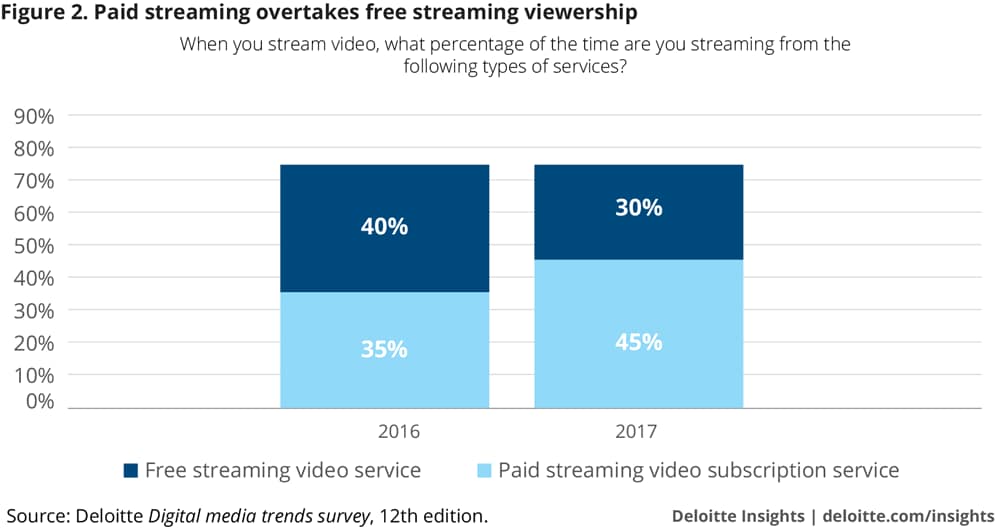
The high quality of original content being offered by video streaming services was officially recognized at the 2018 Golden Globe Awards, when the three largest streaming video services, Netflix, Hulu, and Amazon (by number of subscribers) combined to win 5 of 11 awards in the television category.4
This content appears to be driving an increase in TV streaming: Nearly one-half (48 percent) of all US consumers streamed television content every day or weekly in 2017, compared with just 37 percent of consumers doing so in 2016 (figure 3).
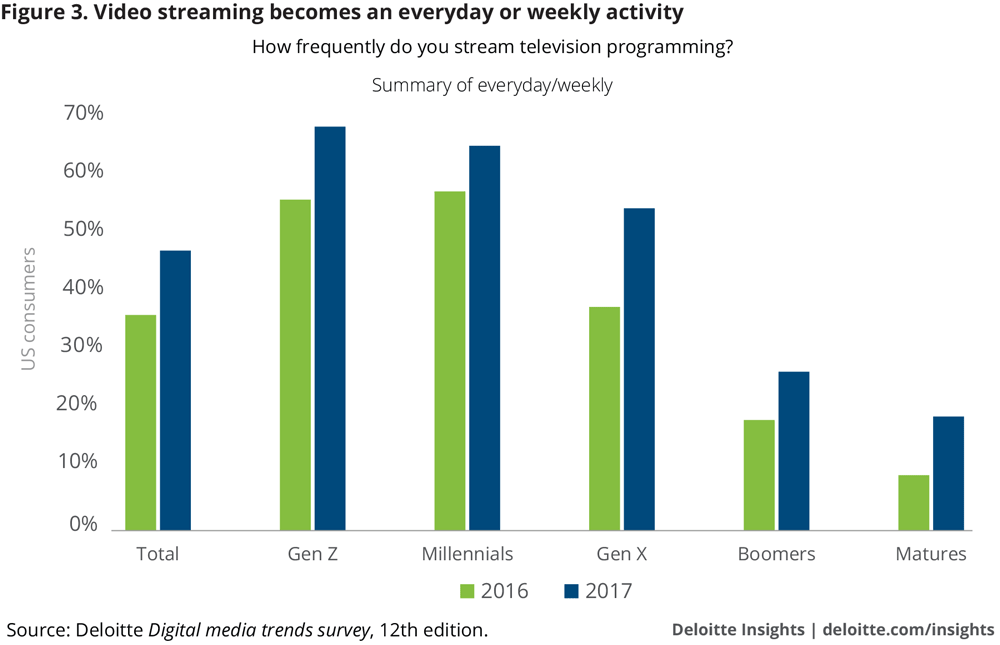
Video streaming trends cause industry to rethink business models
As video streaming becomes more frequent, and as more and more original content becomes available, traditional and premium cable broadcasters will continue to see fierce competition from technology companies that, in just a few short years, have morphed from distribution platforms into formidable sources of programming.
In addition, media companies are increasingly going direct-to-consumer with their own digital streaming services. One challenge, however, is that consumers may be reluctant to pay for exclusive content on top of their other paid subscription services. They may find multiple subscription services to be costly and confusing, and choose to scale back. For this reason, we may see some form of reaggregation over the next year or two as limits on consumer spending could hinder the growth of certain content platforms.
Insight No. 2: Pay TV: minding the value gap
With video streaming enabling unprecedented freedom of choice, consumers are reassessing the value of their current pay TV (cable and satellite) subscriptions as never before.
Pay TV is increasingly under siege because it often does not deliver the value consumers expect in the digital age—the content they want, whenever they want it, on their device of choice. In addition, since many pay TV subscription packages include hundreds of channels (many of them unwanted), content discovery has become difficult for consumers.
As a result, subscribers perceive a widening value gap between what they expect and what pay TV providers actually deliver. In fact, in our survey, nearly one-half of all pay TV subscribers said they are dissatisfied with their service. Cost is a big reason: 70 percent feel they get too little value for their money. This dissatisfaction is widespread, even among boomers and matures, most of whom rely on their pay TV subscriptions for the vast majority of their video entertainment (figure 4).
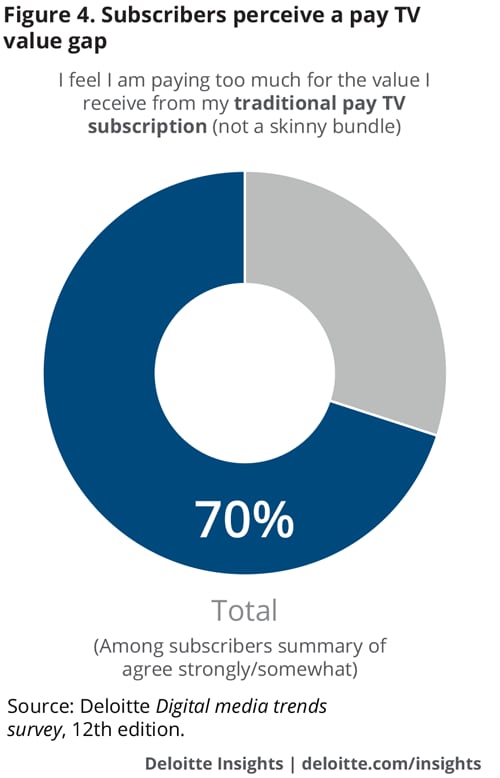
Value gap causes decline in pay TV penetration
In 2017, the pay TV value gap produced an inflection point for providers. Our study revealed that, after remaining steady at about 75 percent for years, pay TV penetration fell to 63 percent in 2017. Among respondents who said they no longer have a pay TV subscription, 27 percent reported they “cut the cord” within the last year.5
Another finding that could prove to be challenging for providers is that 16–22 percent of Gen Z, millennial, and Gen X households have never subscribed to a pay TV service (and are probably unlikely to do so in the future) (figure 5).
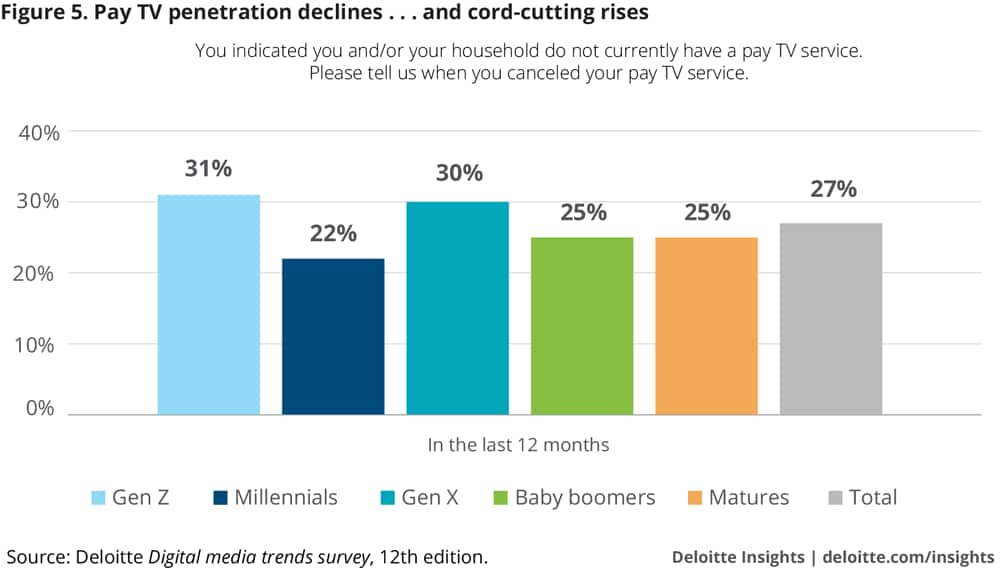
Subscribers are leaving for many reasons
We have noted the widespread dissatisfaction with pay TV among subscribers. But the steep decline in pay TV penetration during 2017 was driven by a variety of factors. Of course, two key reasons were: first, subscribers’ ability to get the content they want elsewhere, primarily through streaming services; and second, an increasing desire for original, high-quality content available only through video steaming platforms. However, our study showed that there are other causes as well:
- 21 percent of consumers without pay TV say they don’t watch enough TV to justify the expense.
- Another 19 percent say they simply cannot afford it.
The threat to pay TV services is not limited to the factors outlined above. Fifty-six percent of current pay TV subscribers say they keep their pay TV simply because it’s bundled with their home Internet access (figure 6). A sizable population of consumer households already get their home Internet from mobile broadband—not from the cable/satellite companies. What could happen when alternative Internet access technologies such as 5G become widely available?

With pay TV and home broadband, most consumers feel they are not getting enough value for their dollar. Streaming services have given them an alternative for their entertainment, and they are starting to cut the cord in earnest. In a couple of years, the availability of 5G could lead them to do the same for connectivity—and encourage those still holding onto their cable and connectivity bundle to drop the whole thing.
Insight No. 3: Emergence of the “MilleXZials”
Perhaps the most startling revelation of our latest survey is the emergence of Generation X as cutting-edge adopters of digital media, on par with Gen Z and millennials. Because the media consumption behaviors of Gen Z, millennials, and Gen X are now so similar, we have nicknamed this combined group the “MilleXZials.”
Whether it’s ownership of smart devices or subscriptions to streaming services, our survey shows that Gen X respondents are matching—and in some cases even surpassing—the digital media behaviors typically associated with their younger counterparts.
Generation X’s emergence as part of the MilleXZial category presents new-age media and entertainment companies with an enticing opportunity. According to a recent Deloitte report, net wealth in the United States will grow from about $72 trillion in 2015 to $120 trillion by 2030. Generation X will experience the highest increase in share of national wealth through the forecast period, growing from under 14 percent of total net wealth in 2015 to nearly 31 percent by 2030.6 This means Gen X now blends digital savviness with relatively high (and rising) levels of disposable income—a dream scenario for providers of media and entertainment solutions. On the other hand, because Gen X consumers are watching more streaming services and watching video on mobile devices, it may be more challenging for pay TV providers to keep them in the fold.
Video streaming is already a mainstream activity for MilleXZials
MilleXZials are driving the streaming phenomenon. In 2017, 70 percent of Gen Z households had a streaming subscription, closely followed by millennial (68 percent) and Gen X (64 percent) households (figure 7).

Not only are MilleXZials streaming—they are doing it often. In fact, each week, about 70 percent of Gen Z and millennials stream movies (compared with 60 percent of Gen X), and 69 percent of Gen Z stream TV shows (compared with 66 percent of millennials and 55 percent of Gen X). MilleXZials’ increased streaming behavior is largely driven by a desire for high-quality, original video content, along with the ability to view this content whenever and wherever they want (figure 8).
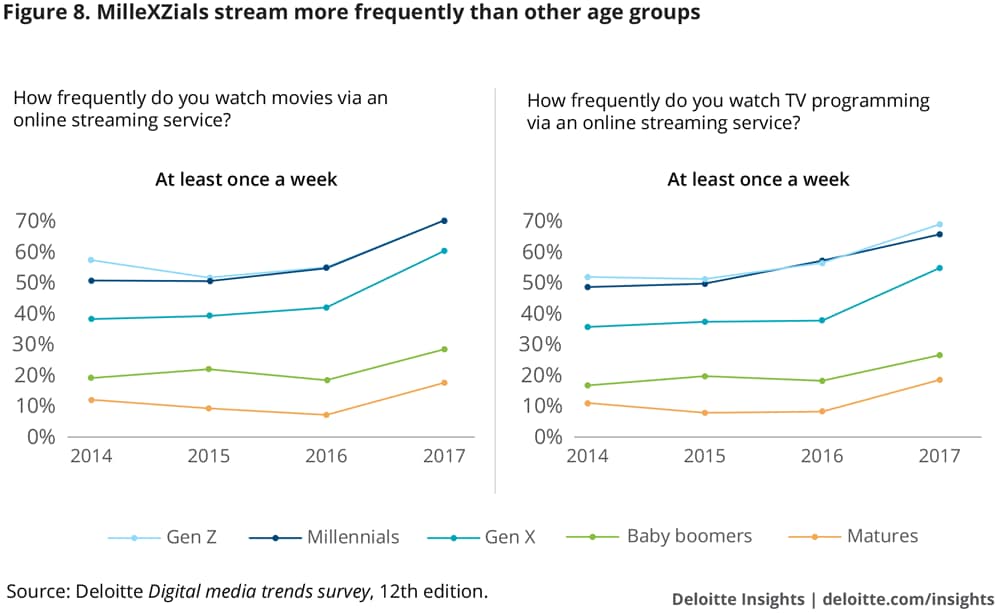
Given MilleXZials’ skyrocketing usage of video streaming, it should not come as a surprise that they’re increasingly seeking content from sources other than pay TV. In 2017, less than 60 percent of millennial and Gen X households had a pay TV connection, which is below the average across the five age groups surveyed (63 percent) (figure 9). This decline in pay TV subscriptions among MilleXZials coincides with their increased video consumption on mobile platforms. In fact, our survey indicates that more than ever before, MilleXZials value mobile data subscriptions as a service (figure 10).
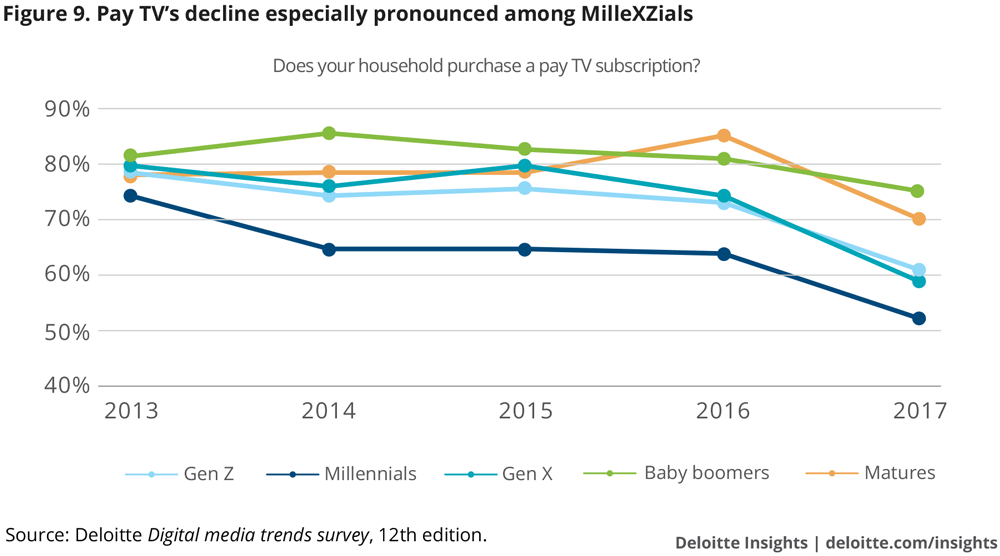
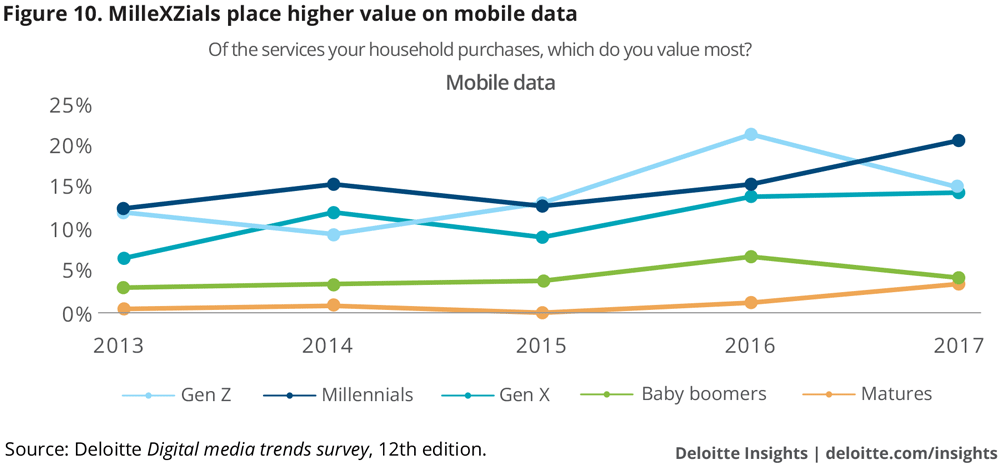
MilleXZials seek broad choice in content formats for mobile devices
As part of their rising usage of video streaming, MilleXZials are steadily boosting their consumption of long-form content (TV shows and movies) on mobile phones. Their consumption of long-form content over the last few years contrasts sharply with that of boomers and matures. Wider availability of unlimited data plans and the increased number of OTT platforms may also be fueling this phenomenon (figure 11).

MilleXZials’ binge-watching behavior also experienced a precipitous rise in 2017. Ninety-one percent of Gen Z, 86 percent of millennials, and 80 percent of Gen X say they binge-watch TV shows, which are each higher than the average across all age groups (75 percent). Binge-watching millennial and Gen X consumers view about seven episodes of a TV series in a single sitting, which exceeds the average number of episodes for Gen Z (six) (figure 12).

MilleXZials also show dramatically increased consumption behavior in the area of gaming, particularly on smartphones. Almost one-half of Gen X respondents report that they play video games frequently (at least once a week), which almost matches Gen Z and millennial respondents. Interestingly, Gen X now leads all generations in the amount of time they spend playing games on their smartphones (figure 13).

Insight No. 4: Personal data: a concern—and an opportunity
We have already highlighted several key trends that reflect what is most important to US digital media consumers. A key factor underlying all of these developments is consumers’ increasing concern about protecting their personal data.
Over the past year, a number of large-scale, highly visible data breaches in the United States may have prompted consumers to want more control over their personal data. In addition, public discussion concerning the rights of European Union (EU) consumers and their abilities to govern personal data may have increased US consumers’ awareness about what could or should be available to them.
In 2017, 73 percent of all US consumers indicated that they were concerned about sharing their personal data online and the potential for identity theft. This number is consistent with the responses to this question in previous years.
However, in 2017, we saw a 10-point drop in willingness to share personal data in exchange for personalized advertising (from 37 percent to 27 percent).
The reason for the sudden change in US consumers’ attitudes is simple: They overwhelmingly lack confidence in companies’ ability to protect their data. Sixty-nine percent of respondents across generations believe that companies are not doing everything they can to protect consumers’ personal data.
This lack of consumer confidence threatens a key growth opportunity for media companies in 2018: targeted advertising. The success of targeted advertising depends heavily on gaining insights into customers’ demographics and viewing behaviors, then augmenting this customer information with social media data. However, if consumers are unwilling to share their data, none of this is possible.
Consumers are willing to share—with some strings attached
The good news, however, is that US consumers still want value-added services from companies, such as premium content, personalized experiences and ads, discounts, and rewards. They just want something in return for their money, time, and/or personal data.
What they want most is visibility into the data being collected and a measure of control over their personal data. Seventy-three percent of all consumers across all generations said they would be more comfortable sharing their data if they had some visibility and control. In addition, 93 percent of US consumers believe they should be able to delete their online data at their discretion.
This “right” to see and control their personal data online may be more valuable to consumers than the actual services they receive. Seventy-six percent of US consumers report that they would choose to delete all of their personal data online if necessary—even if it would negatively impact their level of service.
It would be natural for companies to fear that consumers might rush to delete all of their personal online data and never share it again. However, consumers are willing to share their personal data with companies in exchange for personalized experiences and advertising. According to our survey, that data includes:
- Date of birth
- Video viewing history
- Purchase data
- Contact data
- Browsing history
- Online search history
- Social media activity
- Home address
A new value exchange presents a unique opportunity
For years, consumers have been telling the market what they want and what is important to them and have repeatedly shown a willingness to pay for the services they value. Companies that have aligned their offerings to meet these consumer values have been wildly successful; just look at the explosive growth of video streaming.
A similar opportunity may be arising when it comes to offering visibility and control of personal data in exchange for personalized services and advertising. Whether driven eventually by market regulations, such as in the European Union, or simply by social media and brand reputation concerns, it seems likely that consumer pressure for more control over their personal information will remain. Early recognition and positioning in this new value exchange could create a potentially profitable market.
What’s next? Understanding the power of mobile video
By now, you have probably noticed the common thread running through all of the key trends we’ve highlighted from our latest survey: mobile video. Here are some takeaways on its broad impact:
- Mobile video is fueling the fast-paced growth of streaming across all age groups—particularly the MilleXZials, who comprise Gen Z, millennials, and Gen X.
- Video streaming, in turn, is driving the significant decline in pay TV subscriptions and the growth of alternative platforms that feature high-quality, original content optimized for smaller screens.
- MilleXZials are motivating content providers to reassess their business models to take advantage of market opportunities in the mobile video arena.
- To fully capitalize on this opportunity, however, providers must learn to address the privacy concerns that consumers share across all age groups.
Over the next few years, we will be following the evolution of these trends. We will be watching closely as streaming and mobile video mature, pay TV improves its value proposition or continues its decline, media consumption breaks down generational boundaries, and consumers pushing for more control of their personal data are willing to exchange information when offered more protection.
These insights represent just a portion of the data included in the complete Digital Media Trends Survey, 12th edition. If you are interested in additional insights, please email us at tmttrends@deloitte.com, or continue the conversation with us on Twitter @DeloitteTMT #digitalmedia #tmttrends.




